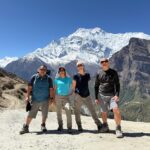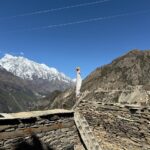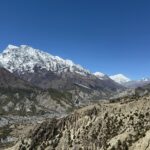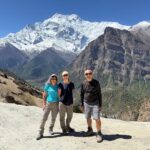
How to Prepare Physically for the Annapurna Circuit Trek
The Annapurna Circuit Trek is one of the world’s most spectacular long-distance hikes, combining rugged mountain trails, diverse cultures, and breathtaking landscapes. But it’s not just a walk in the park—you need to prepare both your body and mind for the challenges ahead.
This guide about how to prepare physically for the Annapurna Circuit Trek breaks down the best fitness training tips, altitude simulation ideas, and conditioning strategies to ensure you’re ready for this epic journey across the Nepalese Himalayas.
Why Physical Preparation Matters for the Annapurna Circuit Trek
The Annapurna Circuit covers a distance of 160–230 kilometers (100–145 miles), depending on the route.
Trekkers face steep ascents, long descents, high-altitude passes like Thorong La (5,416m), and unpredictable weather conditions.
Without proper training, you risk:
-
Injury
-
Severe exhaustion
-
Failing to complete the trek
-
Increased chances of altitude sickness
Solid physical preparation for the Annapurna Circuit Trek boosts your stamina, minimizes injuries, and enhances your overall experience.
1. Start Your Fitness Training Early
Ideally, you should start your Annapurna trek fitness training at least three to six months before your departure.
Gradual progression helps your muscles, joints, and cardiovascular system adapt safely.
Focus on these core areas:
-
Endurance: Build the ability to hike for 6–8 hours a day.
-
Strength: Strengthen your legs, back, and core.
-
Flexibility: Maintain mobility to prevent stiffness.
-
Cardio fitness: Boost heart and lung capacity for oxygen efficiency.
Remember: Consistency beats intensity when it comes to preparing for trekking in Nepal.
2. Build Endurance with Long Hikes
The best way to train for a trek is by hiking regularly with a loaded backpack.
-
Start with short hikes (5–10 km) and gradually increase to 15–20 km.
-
Wear the boots and backpack you plan to use on the Annapurna Circuit.
-
Practice hiking on varied terrain, including hills, dirt trails, and rocky paths.
-
Aim for back-to-back hiking days to mimic real trek conditions.
Training hikes not only build endurance but also toughen your feet against blisters and fatigue.
3. Incorporate Strength Training
Strength training for the Annapurna Circuit is crucial for tackling the steep ascents and descents.
Focus on:
-
Leg exercises: Squats, lunges, step-ups, and calf raises.
-
Core workouts: Planks, Russian twists, and bicycle crunches.
-
Back and shoulder exercises: Deadlifts, rows, and shoulder presses (important for carrying a backpack).
Try to strength train at least twice a week alongside your hiking regimen.
Building strong muscles supports your joints, reduces injury risk, and improves your ability to climb and descend for hours each day.
4. Cardio Training: Boost Your Heart and Lungs
Trekkers often struggle with cardiovascular endurance at high altitudes, where oxygen is scarce.
To condition your heart and lungs:
-
Jog or run 3–5 times per week.
-
Incorporate hill sprints or stair climbs.
-
Try high-intensity interval training (HIIT) to improve oxygen efficiency.
-
Cycling, swimming, or rowing are excellent low-impact alternatives.
Cardio fitness for Annapurna trekking ensures your body can keep moving steadily even as the air gets thinner.
5. Simulate Altitude if Possible
Altitude training for Nepal treks can significantly help your body adapt faster to thin air.
If you live at sea level, consider:
-
Hiking at higher elevations if possible.
-
Using an altitude training mask during workouts to restrict airflow (consult a professional before doing this).
-
Sleeping in an altitude tent to simulate sleeping at 2,500–3,000 meters.
While nothing replaces real high-altitude exposure, pre-acclimatization can reduce your risk of acute mountain sickness (AMS) during the Annapurna Circuit trek.
6. Practice Carrying a Backpack
During the trek, you’ll likely carry a daypack weighing 5–7 kg with essentials like water, snacks, extra clothing, and a camera.
-
Train with a weighted backpack to strengthen your shoulders and back.
-
Adjust the straps correctly for balance and comfort.
-
Get used to hiking uphill and downhill with the extra weight.
If you hire a porter, you’ll still carry your daypack, so backpack training remains crucial.
7. Stretch and Improve Your Flexibility
Tight muscles can cause cramps, strain, and even injuries during multi-day treks.
To maintain flexibility:
-
Stretch after every workout session.
-
Focus on hamstrings, calves, hip flexors, and lower back.
-
Add yoga sessions to your weekly routine if possible.
Staying flexible helps you navigate uneven trails and recover faster between trekking days.
8. Mental Preparation Matters Too
Trekking the Annapurna Circuit is as much a mental challenge as a physical one.
Prepare your mind by:
-
Setting realistic expectations: Some days will be tough.
-
Practicing mindfulness: Stay present and enjoy the journey.
-
Building resilience: Push through discomfort during training hikes.
A positive attitude and mental grit can often carry you farther than pure physical fitness.
9. Listen to Your Body
Overtraining can lead to injuries and burnout.
Pay attention to signs like:
-
Persistent soreness
-
Extreme fatigue
-
Pain that worsens over time
Take rest days seriously and adapt your training plan if needed.
Preparing for a trek is a marathon, not a sprint!
10. Final Preparation: One Month Before Departure
In the final month before your trek:
-
Decrease your training intensity slightly to allow full recovery.
-
Go on a few long hikes with full gear.
-
Break in your boots completely.
-
Practice layering your trekking clothes according to changing temperatures.
-
Review your gear checklist to ensure everything fits and functions properly.
Good preparation reduces pre-trek anxiety and builds excitement for your adventure.
Essential Packing List for Training
Here’s what you’ll need for effective Annapurna Circuit trek preparation:
-
Well-fitted trekking boots
-
Backpack (20–30 liters for training)
-
Trekking poles
-
Hydration system or water bottles
-
Light weights or resistance bands for strength training
-
Comfortable moisture-wicking workout clothes
Investing time and effort into proper training and gear pays off with a safer, more enjoyable trekking experience.
Conclusion: Train Smart and Trek Strong
Successfully completing the Annapurna Circuit Trek demands more than wanderlust; it demands preparation.
By focusing on endurance hiking, strength training, cardiovascular fitness, and altitude readiness, you’ll dramatically increase your chances of not just finishing the trek—but loving every step of it.
So start today. Lace up your boots, load your backpack, and hit the trails near you.
The Himalayas are calling, and with the right preparation, you’ll be ready to answer.










